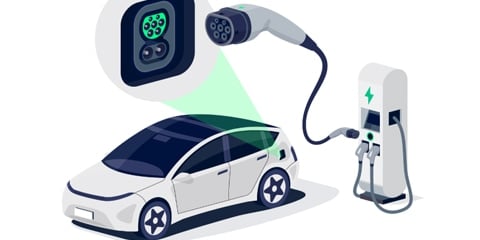If you are new to the world of electric vehicles (EVs) then it can be quite confusing to navigate through all the various terms and acronyms that pop up when researching electric vehicles and electric vehicle charging. You may have have come across Mode 3 32a or Level 2 charging and wondered what it means. Is it that important?
These sort of terms define the different ways that a vehicle can be charged and they appear in vehicle handbooks and websites, so it is useful information to know until such a time when we have a more colloquial or instinctive understanding of what cable to use with what socket.
If you charge your vehicle in Europe, all we really need to know about is Mode 2 and Mode 3 when it comes to charging cables, but here is a quick rundown…
Mode 1 charging requires a cable attached to the car and a cable attached to a home power socket. Mode 1 charging was around in the early days of the EV industry, but it no longer meets the regulations for EV charging as it provides little in the way of safety such as protection against electric shock. Electric vehicles no longer support this mode of charging either.
Mode 2 is the popular method of charging your EV using a mains socket or by using the less common CEE socket. Mode 2 is defined by the inline transformer situated between the power plug and vehicle plug. The transformer is commonly known as a ‘brick’ or EVSE and a Mode 2 charger is also known as a portable charger, mobile charger, or granny charger. So called because it can be taken to your granny’s house! The transformer has a circuit board (PCB) that is capable of performing safety checks and communicating with the vehicle, so it can therefore emulate the functionality of a charging station. However, Mode 2 charging is not recommended as a dedicated method for charging your EV due to the possibility that the power outlet may not be sufficiently protected from the impact of charging your vehicle at high loads over long periods of time. Mode 2 chargers are therefore only intended for occasional use. Regulations for Mode 2 charging also stipulate that the cable between the power plug and the inline transformer must be a length not exceeding 300mm, which is why using an extension lead is not advisable. We have a range of Mode 2 chargers here.
Mode 3 charging describes a piece of equipment that is capable of coping with all of the requirements for using a power supply as a dedicated method for charging an EV. A wall charger installed outside of homes or inside a garage and the majority of public charging points that do not have a charging cable attached to them are Mode 3 chargers. Mode 3 chargers use Alternating Current (AC) to the Onboard charger of the vehicle and the Onboard charger then converts the current to Direct Current (DC) to the car battery. Because all of the safety checks and communication with the vehicle is carried out by the charging station, it only requires a cable to connect with the vehicle. If a mode 3 charger does not already have a cable attached, then a charging cable is required with two connectors (or plugs), one that plugs in to the charging point (the majority of these charging point sockets in Europe are known as Type 2) and the other connector will plug in to the vehicle socket, which will be a Type 1 socket or Type 2 socket, depending on which EV you have. You may therefore have heard of the Type 2 to Type 2 charging cable and Type 1 to Type 2 charging cable. These cables will either be capable of providing 16A or 32A current (hence the aforementioned Mode 3 32a) and will either be a 1 Phase or 3 Phase cable.
Mode 4 represents the fastest mode of charging available and is widely known as a DC rapid charger. The unit can bypass the Onboard charger of the vehicle and provide current directly to the battery of the EV. Mode 4 chargers can therefore provide more current to the EV, a lot more in fact and this can significantly speed up the time it takes to charge your vehicle. EV’s will need a Combined Charging Socket (CCS) or CHAdeMO socket to take advantage of Mode 4 charging. CCS sockets are available with Type 2 socket vehicles (mainly fully electric models) and, as the name suggests, is combined with the Type 2 socket. CHAdeMO sockets are included with some Type 1 vehicles and are separate to the the Type 1 socket.
What About Level 1 Or Level 2 Charging?
Without getting into the technical nitty gritty, the easiest way to understand Level 1 and Level 2 is that it is essentially the same as Mode 2 and Mode 3. Level 1 chargers relates to Mode 2 charging, so it is the mains socket charger. Level 2 chargers relates to Mode 3 charging, so it is the Type 2 to Type 2 and Type 1 to Type 2 cables.
Level 3 is the DC charger, so it is the same as Mode 4.
© 2022. Please do not reproduce without our permission



